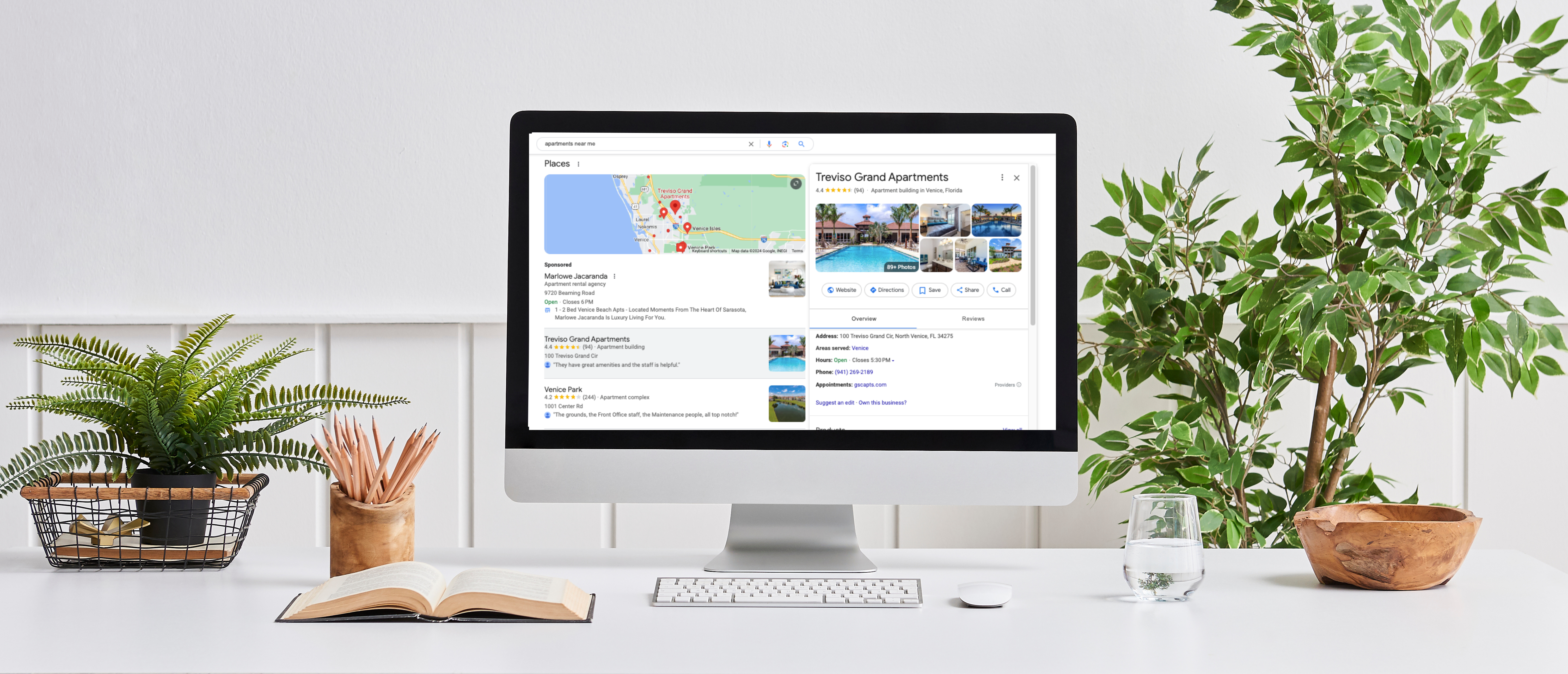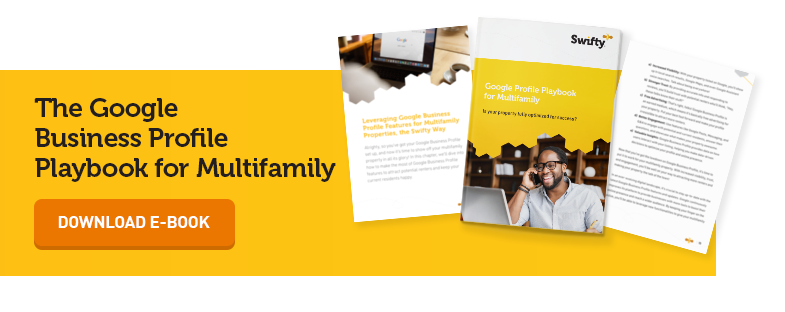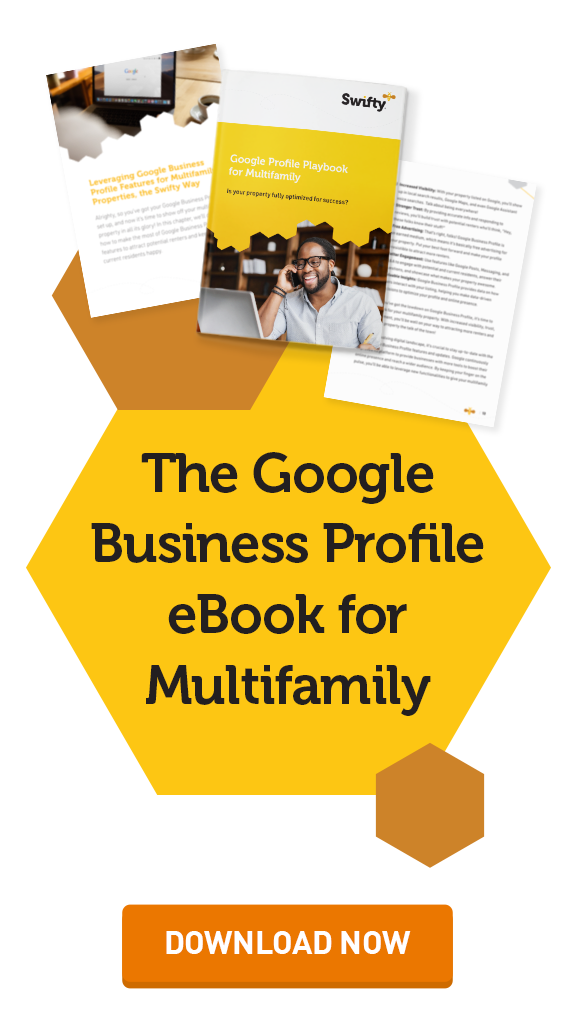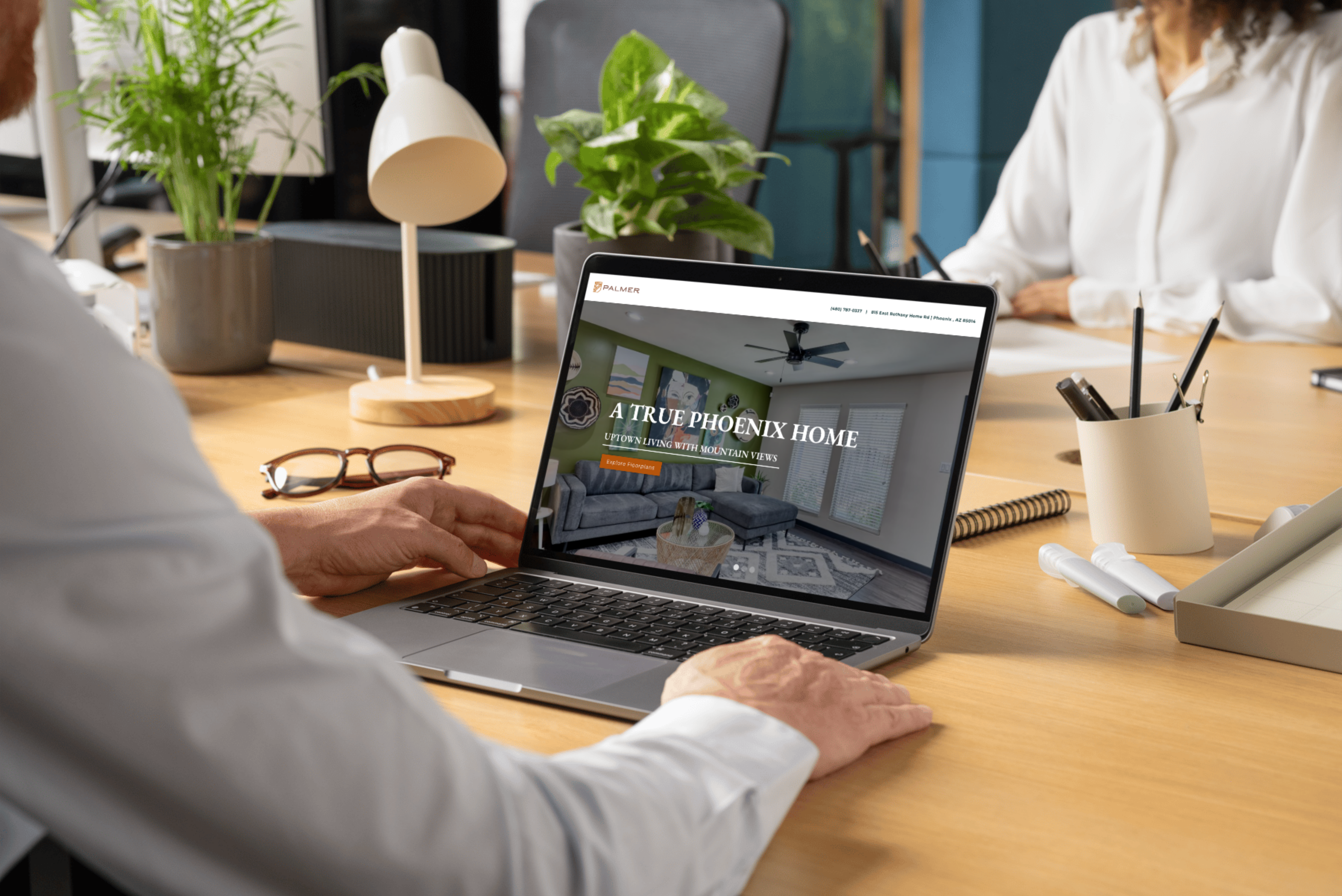Your Google Business Profile (formerly Google My Business or “GMB”) for your multifamily property is an essential tool to increase your website’s visibility and ranking and therefore capture more of that organic traffic who is searching for an apartment in your area. For businesses like multifamily properties with physical locations, it is especially important because it allows you to list your property in Google Maps, making it easier for potential renters to find you.
What Is a Google Business Profile?
Google Business Profile (GBP) is a free tool that helps businesses like multifamily properties appear in Google Search and Maps results. Your multifamily GBP listing can include important details about your property, such as your hours of operation, contact information, website URL, available floorplans, and more.

You can also publish posts to your GBP (just like social media) with property updates, leasing specials, and other promotional content that will capture the attention of prospects. These posts are also a great way to keep your property profile active and engaging, which can boost your visibility in local searches.
To publish a post on your GBP, simply log into your account, click on the “Posts” tab, and select “Create Post”. From there, you can add images, text, and relevant links back to your multifamily website. It’s just like posting on social media but directly reaches those searching for your property!
Pro Tip: Don’t forget to add emojis to make your posts more eye-catching and include relevant hashtags to boost visibility (e.g., #ApartmentLiving, #PetFriendly, #MoveInSpecial)

Google reports that 40% of businesses have never posted on their Google Business Profiles, indicating a significant area for potential engagement and visibility that is currently underutilized. If keeping up with consistent posting like these isn’t something you feel you have time for, our GBP management service handles everything, from weekly posts to optimizing your profile from top to bottom.
Why Is Having a Google Business Profile Important for Multifamily Marketing?
There are several reasons why a Google Business Profile is essential for your multifamily marketing strategy. First and foremost, Google makes it easier for potential renters to find your property. For example, when a potential renter types in “apartments near me” or “apartments in denver, co” in the search bar, Google will show them a map with apartment listings and links to each property’s website. A well-optimized GBP can help your property appear above the competition in your area.
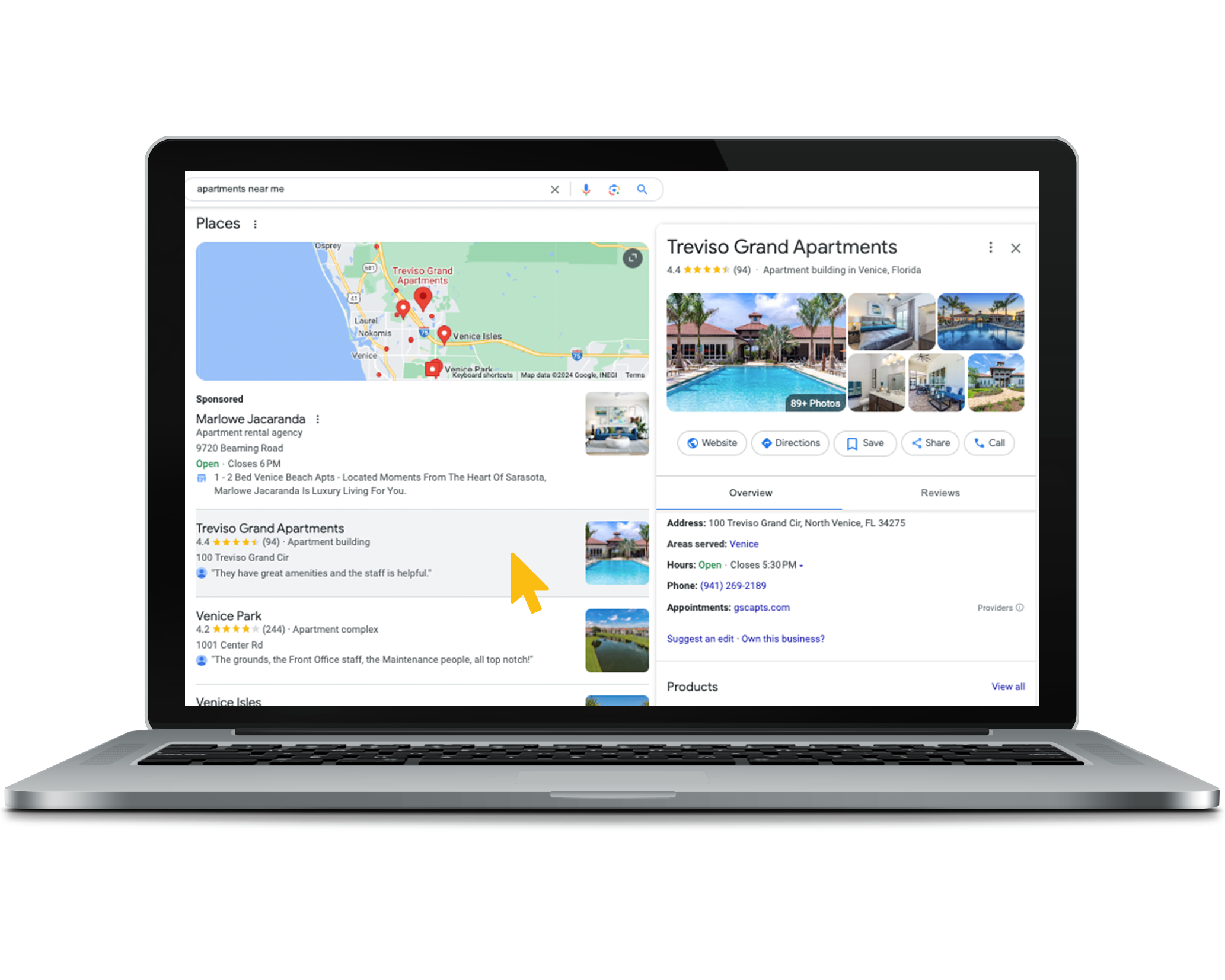
If your apartment complex has a business listing, it will appear on the map (provided you have optimized your listing), making it more likely that potential renters will click through to your multifamily website.
In addition to making it easier for potential renters to find you, Google also provides valuable insights into how people are searching for apartments online. The “Insights” tab on your Google Business Profile dashboard will show how many people have viewed or clicked on your listing and what keywords they used to find you. This information can help tailor your multifamily marketing efforts to better reach potential renters.
Consider these Google Business Profile stats from Google, RedLocalSEO, and Birdeye as of 2024:
- 64% of people have used Google My Business to find a local business’s contact information.
- 56% of customer actions on Google My Business listings are website visits.
- Customers are 2.7 times more likely to consider a business reputable if they find a complete Business Profile on Google Search and Maps.
- Customers are 70% more likely to visit and 50% more likely to consider purchasing from businesses with a complete Business Profile.
- Verified businesses average 1,803 monthly views, predominantly from discovery searches.
- 24% of businesses with verified Google Business Profiles get more than 50 calls per month.
This is just the tip of the iceberg when it comes to the data that backs up implementing a solid Google Business Profile process into your 2025 multifamily marketing strategy.
6 Easy Ways to Optimize Your Multifamily Google Business Profile
Now that you know why an established Google Business Profile for your multifamily properties is important, let’s take a look at how you can optimize your listing.
#1. Verify your business page.
Verifying your multifamily Google Business Profile is important because it gives a level of credibility to your property and gives you complete control over the information on your profile. You’ll be able to make updates at any time and utilize all of the tools available to you.
This also makes your property more visible on Google Maps and in local apartment search results, establishes trust with potential renters, and provides helpful insights into how prospects are interacting with your profile.

To claim your multifamily Google Business Profile, follow these steps:
- Verify and claim your business listing.
- Link the listing to your multifamily website.
- Add high-resolution photos and videos of your units and community.
- Write a full and accurate description of the property.
- Add floorplan images to the “Products” section.
- Add your resident and community amenities to the “Services” section.
- Add local citations to enhance your Name, Address, and Phone (NAP) Score.
- Create Google long-form posts to promote resident events, special offers, new amenities, and more.
This will help you have the best chance to catch more organic searches of renters looking for properties in your area.
#2. Fill out all fields in your listing completely and accurately.
Include all relevant information about your apartment complex, such as your leasing office hours, contact information, website link, amenities, floorplans, etc. The more information you can provide, the better!
#3. Add photos and videos of your property.
People love visuals! Adding photos and videos of your apartment complex will make it more likely that potential renters will click through to your listing. You can even add a virtual tour of your units so people can get a feel for what it’s like to live at your property without ever having to leave their couch!
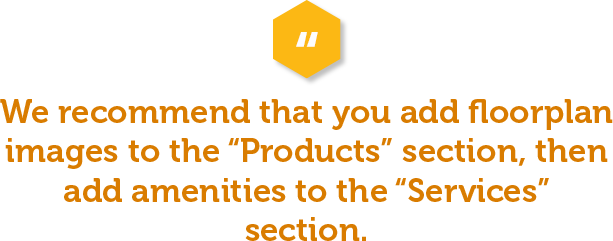
We recommend adding floorplan images to the “Products” section and resident and community amenities to the “Services” section of your profile.
Your photos will likely be a prospective resident’s first impression of your property, so be sure only to use high-resolution photos. Your residents can also upload their photos of the property with their reviews; this allows prospects and potential renters to relate to your community and provides additional opportunities to build trust and authority with Google.
#4. Respond promptly to reviews (both positive and negative).
Did you know that 84% of people trust online reviews just as much as referrals from their friends? Also, keep in mind that 97% of customers say that reviews influence their buying decision. And these stats also apply to multifamily apartments.
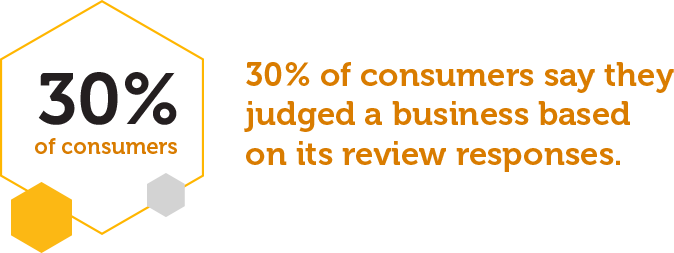
Promptly responding to reviews shows you care about what renters say about your community. It also shows that you are willing to listen to feedback and make changes accordingly. In fact, 33% of customers who received a response after posting a negative comment or review on a business turned around and gave a positive review; meanwhile, 34% of those people deleted the original negative review.
In short, your review response might seem small, but it can make a big difference!
#5. Add UTM codes to your profile links.
Next, you’ll want to track how effectively your business profile is directing traffic to your multifamily website. To do this, you’ll need to add Urchin Tracking Module (UTM) links to the URLs on your profile.
UTM codes are unique pieces of text that you attach to the end of each URL; these allow you to easily identify any traffic that comes to your multifamily website when a user clicks on those specific links. These links are great for special campaigns, ads, emails, Call-to-Action buttons, and social media. In other words, you’ll be able to identify if users arrived at your site from one of the links on your Google Business Profile or somewhere else.
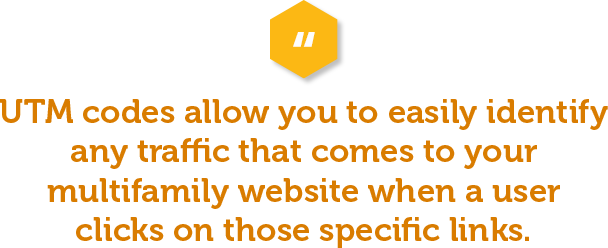
You can easily build your UTM codes here.
#6. Increase your NAP Score.
It’s important to keep your phone number and address up-to-date not only so potential renters can easily get in touch with you if they are interested in booking a tour or learning more about your property but also to improve your NAP Score.
Creating consistent local citations is a simple way to improve your ranking in the maps section. Building citations improve your Google authority and increase the consistency in which your brand is represented by your Name, Address, Phone (NAP) Score.

Making sure your citations are consistent is essential. For example, if Google sees a phone number on your community’s business profile, then crawls your site and sees a different phone number, Google will flag you. This “red flag” will penalize your property’s SERP ranking, as Google thinks your brand is untrustworthy.
Bottom line: For best results, you must cross-check all information about your property with your website and anywhere else your property’s contact details may appear online to ensure accuracy and consistency.
Provide Prospects With the Information They Need When They Need It
A Google Business Profile is essential for any multifamily property that wants to be visible in SERPs and attract more prospective residents. By taking the time to optimize your apartment complex’s business listing, you will be able to reach more people and provide them with the information they need to make a renting decision.
